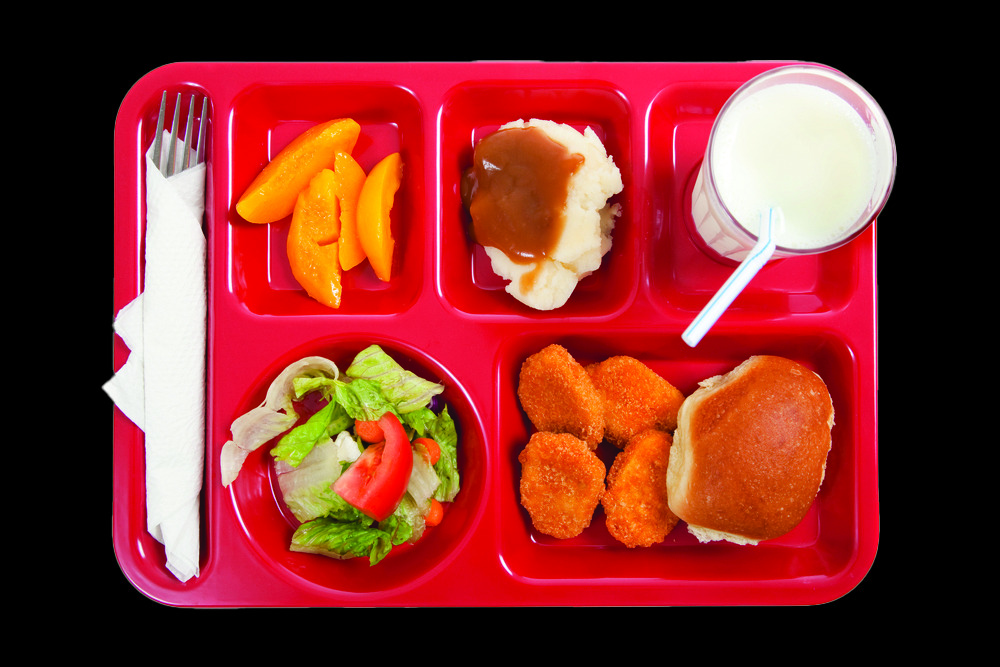At noon somewhere in America, the lunch line shuffles forward.
A tray clatters with a limp square of pizza, edges curling like old and wet cardboard and a half-scoop of syrupy peaches from a can, the only color on a plate otherwise gray with a stale roll.
A quick grab at the milk carton, barely a gulp left after the first sip, and they’re done, stomachs still grumbling as hunger seeps in deeper.
For this student, it’s just another day, waiting for something better, or just something more, to fill the tray.
New “Make Texas Healthy Again” legislation is to be passed through multiple house and Senate bills. The legislation’s primary focus is to specifically improve the health of kids in public school; Senate bill 25 will increase the amount of required physical education hours for middle school students, and Senate bill 314 (House bill 1290) will ban certain food additives in school meals.
In addition, the legislation includes Senate bill 379 (House bill 3188), which will ban families in the Supplemental Nutrition Assistance Program (SNAP) from using food stamps on foods labeled as unhealthy. These bills are part of Texas’ ongoing obligation to combat the broader problem of record-high rates of obesity and other diseases.
Food Service Director Brennon Turner believes that the current emphasis on “making Texas healthy” is a step in the right direction.
“A lot of (diseases) are correlated to your diet and what you put in your body,” Turner said. “I think (the legislation) is a positive move, because our tax dollars should not be going to subsidizing junk food.”
Although the bills are targeted towards public schools, private institutions like St. Mark’s can still be tangentially impacted. Members of the food service team have already paid extra attention to reconciling taste with nutrition.
“We just try to build a menu that, of course, (students) like,” Turner said. “(Students) give us a lot of feedback, and the community has been operating here for a long time. But when we build those menus, we’re also thinking about the nutritional value.”
Many systems are in place to ensure that students get the best bang for their buck in terms of their diet. Pleasing everyone on campus is certainly a challenge, but SAGE navigates it quite well.
“We build menus that are well balanced between nutrient-dense items,” Turner said. “That’s kind of set up on the menu too, because we tag (items) with the color that represents the nutrient density of each one, and then we use those colors to try to create a menu that has good balance.”
The majority of SAGE’s food comes from trusted local distributors who pay attention to the quality of their goods — after all, a dish’s nutritional value is largely determined by its ingredients.
“For the food items, we have a broadliner, who’s our distributor,” Turner said. “They do most of our groceries, they do some of our produce, and of course, we get some proteins from (a different provider). Some of our proteins come from another provider called Crystal Creek.”
In lieu of this legislation, Turner recommends staying away from ultra-processed snacks outside of school. Athletes, in particular, should limit consumption of foods high in unhealthy fats and sugars.
“We try to encourage (students) to eat whole foods,” Turner said. “That’s the main thing: start up whole foods. Eliminate sodas from your diet. Stick to your water, your whole foods and your whole grains. Those are the things that your body can absorb, break down and use for energy.”
Texas consistently ranks near the bottom in national health metrics, especially for children, a persistent issue School Nurse Julie Doerge ties to diet and activity levels. She says past efforts like the “Make Texas Healthy Again” bill have been brought up in politics, but actually accomplishing it with different schools’ limited resources will be a challenge.
“Ultimately, I think it’s a good change, since it’s tackling unhealthy habits and adding a 30-minute PE class for everyone,” Doerge said. “But the cost for schools is a big hurdle.”
Funding remains the sticking point. Doerge notes that great ideas often falter when they reach cash-strapped towns, where public school lunches lean heavily on cheap carbohydrates and sugary items that lack nutritional value.
Nearly everything is processed since schools need to feed thousands of kids, there’s no chance for a home-cooked style meal.
The Michael and Susan Dell Foundation’s data support Doerge’s reasoning: 1.8 million Texas kids miss out on proper nutrition, with 33 percent skipping vegetables entirely and 90 percent snacking on sweets daily.
In other words, wealthier families can stock up on fresh foods, while those on tight budgets, like SNAP recipients, rely on cheap and nutrition-sparse meals like pasta and bread.
“Who wouldn’t support more food and veggies for kids?” Doerge said. “I’m glad others are thinking about how to address this.”
But that funding gap hits hardest in rural areas, where schools are lifelines, providing breakfast and lunch to kids who might otherwise go hungry, especially over the summer. Doerge says she worries that without serious financial backing, the bills won’t deliver for those who need them most.
Closer to home, she sees parallels in student habits here on campus, where students skipping meals can lead to preventable health complaints like “getting headaches because they skipped breakfast or not having a meal in 12 hours.”
“Your blood sugar has probably crashed down to the basement, and your brain’s starving,” Doerge said. “You need food to think straight. The difference is the kids here can choose to skip eating, but in those lower-income neighborhoods, they don’t get the luxury of choice.”
Beyond campus, Doerge envisions our campus playing a role in easing these disparities. Doerge suggests tracking daily food waste, pounds of uneaten meals tossed out, and using that data to push for change, building on past efforts to donate leftovers like day-old bread to places in need.
Doerge sees our community as being able to help the bigger picture. Donating ripe fruits and imperfect vegetables to struggling ISDs could extend the school’s impact, echoing past efforts to redirect leftovers.
She ties this to a core belief: good food fuels better lives, a principle the legislation aims to champion despite its hurdles.
“We know good food helps kids do better in life,” Doerge said. “It’s a small step we could take to support healthier eating beyond our walls.”








